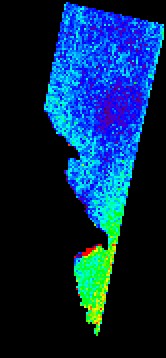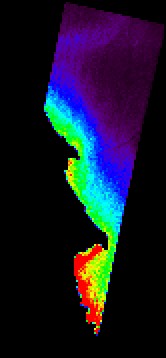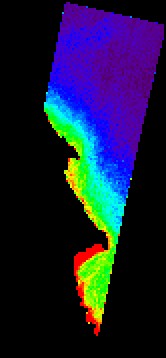| Satellite remote sensing of the bio-optical parameters of the coastal waters can become an important tool in monitoring the coastal environment. The currently operating ocean color instruments such as MODIS and SeaWiFS meet the needs of global ocean monitoring, but their spatial resolution is too coarse for coastal applications. High resolution Landsat-type of satellite sensors often do not have the spectral specificity for quantitative study of the coastal waters. Imaging instruments with many spectral bands and a high spatial resolution are required for quantitative analysis of the coastal systems.

The EO-1 Satellite The Hyperion imaging spectrometer is one of the instruments on board the NASA's Earth Observing 1 (EO1) satellite. It has a spatial resolution of 30 m and over 200 contiguous spectral bands ranging from the visible to the short wave infrared regions. The Hyperion instrument is designed primarily for land applications and the signal-to-noise ratio is often thought to be sub-optimal for ocean applications. Nevertheless, case II waters such as coastal waters with high sediment load usually have a higher reflectance in the visible wavelength region than the clear Case I waters in the open oceans. Hence, the signal-to-noise ratio of Hyperion data over coastal waters may be sufficiently high, such that meaningful measurements of the optical properties of the coastal sea waters may be possible. The objective of this study is to investigate how well the Hyperion data can be used in retrieving the optical properties of coastal waters.

Reflectance Measurement Our approach involves spectral fitting of the hyperspectral reflectance spectra to a model that includes both the atmospheric effects and the scattering and absorption of light by the sea water constituents. The optical parameters retrieved are the absorption coefficients of chlorophyll and dissolved organic matter, and the backscattering coefficient of suspended sediments, all evaluated at a reference wavelength of 440nm. The results are compared with the MODIS level 2 ocean products for an almost-simultaneous MODIS scene acquired at the same day as the Hyperion data acquisition.
The absolute calibrated water leaving radiance in the blue-green spectral regions derived from Hyperion data agree very well with the corresponding MODIS level 2 parameters.
The scattering coefficient of suspended solids at 440 nm and absorption coefficient of dissolved matter at 440 nm retrieved from Hyperion have strong correlattions with the band ratio of reflectances at 489 nm and 550 nm. The retrieved chlorophyll absorption at 440 nm has a weaker correlation with the band ratio. The conventional band ratio based algorithms chlorophyll retrieval are well-known to have problems when applied to coastal waters where scattering from sediments and absorption of dissolved organic matter complicate the retrieval of chlorophyll. Using hyperspectral data and a suitable model of the water-atmosphere system, the backscattering and absorption coefficients of the three constituents of coastal water can be retrieved.
Acknowledgment:The project leader Dr. S. C. Liew is a Principal Investigator in the NASA's EO-1 Science Validation Team. The Hyperion data were supplied by NASA EO-1 mission science office. The support and assistance given by the EO-1 Mission Science Office are greatly appreciated. The MODIS Level 2 products were obtained from NASA GDAAC
|






